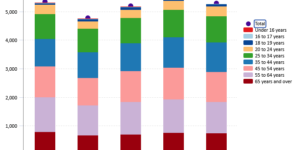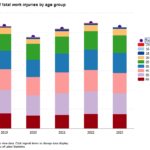With no intention of disintermediating anybody, IVANS is rolling out new commercial lines “digital distribution capabilities,” which the firm promises will give carriers a “data-driven method” to find new agents and grow with existing partners.
“Our tool is meant to be enabling,” Matt Foran, vice president and general manager of IVANS Market Appetite, told Carrier Management and Insurance Journal last week, referring to the release of “Market Manager”—an expansion of an earlier rollout called “Market Appetite.” Unlike other “digital distribution” tools, neither “Market Appetite” nor “Market Manager” is a digital path between policyholders and insurers. The aim instead is to strengthen and increase the connections between carriers and agents.

“The cost of distribution management is very substantial, especially when [carrriers] are doing state expansions or new industry expansions,” Foran said as he displayed a sample screenshot of the Market Manager tool for a carrier looking to grow with agencies writing BOP for doctors’ offices in the state of Alabama. The screenshot displayed a list of 16 agency names associated with “SIC Code 8011-Offices and Clinics of Doctors of Medicine-BOP-AL,” ranking them “based on 19 points of an algorithm.” Agencies having greater “density in the space”—a higher volume of premium and policies—appear at the top.
“We’re dynamically building these lists based on who the user is and on a number of other variables,” he said, explaining that two of the highest‑weighted variables are premium and policy count volume, without specifically revealing any of the others 17 variables relevant to carriers doing a search.
“It shows the carrier who these agencies are by name. We don’t give volume statistics or transactional details. It’s a very high‑level explanation for who to go talk to,” he said. On the sample list, only three names on the 16-member list had stars next to the names indicating that the agencies already had appointments with the carrier seeking the information.
“Knowing who to go talk to, especially if it’s a new state, is a very time-consuming, expensive adventure of basically going door‑to‑door and trying to drum up a good conversation,” Foran said.
 Indeed, the tool’s creation grew out of a conversation with a carrier looking to grow in a particular segment and state—habitational in Pennsylvania—but not having the best information to proceed. When the carrier shared a list of agencies they thought were the top 10 in the state, they actually named—and appointed—only four, Foran said, noting that the carrier also only had appointments with 20 of the top 75.
Indeed, the tool’s creation grew out of a conversation with a carrier looking to grow in a particular segment and state—habitational in Pennsylvania—but not having the best information to proceed. When the carrier shared a list of agencies they thought were the top 10 in the state, they actually named—and appointed—only four, Foran said, noting that the carrier also only had appointments with 20 of the top 75.
“Our question to them was, ‘What is the value of a new appointed agency in three years?’ The response was ‘$1.5 million in premium,'” he said.
Not Just Doughnuts. Data Drives Efficiency
A single agency appointment won’t produce over a million dollars for every carrier. But a process designed to deliver clear, up-to-the-minute descriptions of underwriting appetites to agency partners will cut carrier costs associated with unquoted submissions—by $100 for some accounts—Foran said, explaining the impetus behind IVANS’ 2015 rollout of Market Appetite—the precursor to Market Manager.
Some “very tiny pieces of business” may generate less than $100 in expense per declined account. “But it’s still a cost,” said Foran, a former director of distribution and marketing strategy for specialty products at Zurich Insurance Group, describing the time and costs associated with activities like opening the email, taking the documents out, and putting the submission into clearance and registration.
 Time is money for agents too, he contends. “Agents, who very much want to do the right thing by their carriers, don’t have a good mechanism to understand, at the level of detail that’s appropriate, what to send their partners,” he said. Explaining the lack of detail, he recounted his own personal experience on the producer side from a stint at Marsh, when carrier marketing reps would show up with bagels and doughnuts to describe their underwriting targets.
Time is money for agents too, he contends. “Agents, who very much want to do the right thing by their carriers, don’t have a good mechanism to understand, at the level of detail that’s appropriate, what to send their partners,” he said. Explaining the lack of detail, he recounted his own personal experience on the producer side from a stint at Marsh, when carrier marketing reps would show up with bagels and doughnuts to describe their underwriting targets.
“They could really only tell you about two or three things with limited depth and leave a business card behind that you’d hope to take a note or two on. So, when you had that next manufacturing firm [potential account] come across your desk, you would dig through 1,500 business cards and hope to find the one that said manufacturing on the back.”
Foran continued: “If you think about the methods by which this industry works through routing of risks, it’s very much experiential, which is why your greatest tenured brokers are very valuable. They know where to send things, and they have the relationship and trust” to get to answers quickly.
 But “that’s some very small percentage.” For the most part, remaining agents and brokers are using a “shotgun method”—sending submissions out to carriers who they think might have interest and hoping for the best. “It’s why, as an industry, the declination rate for carriers is somewhere around 60 percent,” he said, quoting a figure from EvoSure, the builder of Market Appetite, which IVANS acquired in 2015, stating that this was confirmed from his own prior experience working for an insurer.
But “that’s some very small percentage.” For the most part, remaining agents and brokers are using a “shotgun method”—sending submissions out to carriers who they think might have interest and hoping for the best. “It’s why, as an industry, the declination rate for carriers is somewhere around 60 percent,” he said, quoting a figure from EvoSure, the builder of Market Appetite, which IVANS acquired in 2015, stating that this was confirmed from his own prior experience working for an insurer.
For carriers, the high level of “out-of-appetite submissions” is not just an expense issue, he suggested. “It also means that [if] these carriers microsegment their business and become far more intelligent in terms of where their sweet spots are for driving profitable growth, [that] it is nearly impossible for them to use their current methods to drive that message effectively and efficiently to their distribution base.”
A Walkthrough
Market Appetite, which is free to agents using other IVANS products—30,000 in total—adds value to this distribution network by allowing agents to be more effective with carrier partners, Foran maintains. To date, 3,500 of the 30,000 have already signed up to use Market Appetite.
![]() The companies who are stated in our system have roughly an 11X improvement in search visibility and deeper research by the users.
The companies who are stated in our system have roughly an 11X improvement in search visibility and deeper research by the users.
“So, our system, on Day 1 when we turned it on, had 1,400 markets available for agents to search,” he said, explaining that some of the nearly the 400 carriers represented have multiple operating companies showing up on the system. The Day 1 “historical data-driven appetites,” Foran said, “are imperfect…but very powerful.” The power of the tool lies partly in the fact “it’s more up to date” than what they’d get at those occasional bagel or doughnut breakfasts. “Our algorithms run every single day,” he said.
A screenshot of the Market Appetite results for “NAICS Code 531110 Lessors of Residential Buildings and Dwellings”—63 markets in total—showed:
- Those with a history of binding that type of risk, but who haven’t specifically paid to provide appetite descriptions, listed with a small icon that looks like bar graph indicating that the risk is within its “historical appetite” derived from transactional data.
- Markets that paid to submit appetite details displayed with a “thumbs-up” or “in-appetite” icon, positioned above the “historical appetite” group on the list.
- Carriers with which the agencies have appointments positioned ahead of carriers they are not contracted to represent in both the stated and historical appetite sections.
Foran noted that agents can also click further on a market with a stated appetite to see “custom content” that carriers pay to provide, articulating exactly what they want to a greater degree—sometimes with links to portals in IVANS system or to marketing materials and email contacts. The sample carrier included in the “Market Appetite” demo for Carrier Management and Insurance Journal, for example, clarified that apartment buildings, garden-style apartments, and 1-4 unit dwellings, as well as assisted living and independent living locations are within its “residential real estate and habitational” BOP appetite, as are office buildings, industrial parks and self-storage facilities, among other locations.
“The companies who are stated in our system have roughly an 11X improvement in search visibility and deeper research by the users. There’s a very high correlation with being stated and getting value for that,” Foran said.
Carriers also pay for access to “Market Manager,” giving them access to a platform to find the agencies that have the business that they want. “It’s a very carrier-centric business model because we believe that they truly do gain the greatest value from this,” he said.
Do carriers have an objection to noncontracted carriers showing up when agents look for underwriting appetites that jive with their client accounts?
Foran said no, noting first that the contracted carriers are at the top of the list that gets generated for the agent, and the agents would naturally gravitate toward those names anyway. In addition, the carriers get the benefit of being able to communicate appetite adjustments to their agency forces as they happen. “The classic example is that there are many carriers that woke up one morning and realized that workers comp in California was not a place they should have been. So, they shut it down. The [historical] data would still show them as writing that business, though, [as] would the experiential knowledge” of agents.
“In our system, they can call us up and say, ‘We want a thumbs-down in that area. Please, turn this off. And It’s updated across our platform to every one of 3,500 agencies using the tool,” he said.
 “We’ve built this as enabling tool, not a disruptive tool,” Foran said. “We feel this is a big step change forward in terms of improving the distribution relationships across the industry, in a good way for both sides. This does not negatively impact folks. This is very much good for the agency, good for the carrier. It’s very simple. It’s easy to use. It’s informed through data. This is not guessing. This isn’t scraping websites and hoping that the way that they’ve articulated themselves is reasonably fair.
“We’ve built this as enabling tool, not a disruptive tool,” Foran said. “We feel this is a big step change forward in terms of improving the distribution relationships across the industry, in a good way for both sides. This does not negatively impact folks. This is very much good for the agency, good for the carrier. It’s very simple. It’s easy to use. It’s informed through data. This is not guessing. This isn’t scraping websites and hoping that the way that they’ve articulated themselves is reasonably fair.
“This is just straight-to-the-point so that people can go and have the right conversations”—agents, in terms of who they send their submissions to, and carriers, in terms of who they should would with to the best distribution footprint for the lines they want to write,” he said.
- RiskMatch: Unlocking $120B in Premium Opportunities for Carriers
- Taking a Test Drive: A Carrier CEO Tour of RiskMatch
- RiskMatch: More Carrier Benefits Summarized
As of June 2016, RiskMatch reported that 120 brokers and carriers were using the platform representing a $14 billion platform size.
“The point of difference is us having 1,400 markets visible in our system out of the gate in an Appetite view [and] integrated into agency management systems,” said Foran, when asked to distinguish IVANS from RiskMatch. “We also have data of 30,000 agencies,” he said.
Foran also believes RiskMatch, in some respects, is more akin to the APM (Applied Performance Management) tool of IVANS parent company Applied. APM and RiskMatch allow for more “siloed” agency “analytics,” he said. APM’s website describes analytics, such as business retention and growth reporting, agency employee performance tracking, and insurer performance (policy volume and revenue, new business and submission activities) with a particular agency.
Who is IVANS?
Beyond the goal of facilitating better relationships, Foran admits another impetus for IVANS to develop the new tools was to give more visibility to IVANS and its under-the-radar data network between carriers and agents.
Although IVANS has been connecting the data of agencies and insurers for 30 years, “If you ask how information shows up in their agency management system, they know that happens, but they have no clue who actually does it,” Foran said. “Over the last two years, there’s really been a push to think about how an organization like IVANS can deliver greater value as a strategic part of distribution,” he said.
Applied Systems acquired IVANS in 2013, and while Epic, Applied’s cloud-based agency management system, is the easiest to integrate the new tools with, Foran said Market Appetite has been integrated in a total of nine agency management systems already. In addition to Applied’s Epic and TAM, it’s also integrated with HawkSoft, Xanatek, eVo, and NASA, for example. For those systems that don’t have an integrated option, it is available to agents for free through ivansinsurance.com, he said.
More Market Insights: Tracking Renewal Rates
 In conjunction with last week’s introduction of Market Manager, IVANS also introduced a tool known as Market Insights, delivering an IVANS index of data on renewal premium changes to all agents on its systems and to carrier clients. “It is a time series‑based view of what’s happening on a product‑by‑product basis in terms of premium renewal rate,” he said, noting that each data point captured and included in the renewal change index relates to a single policy number-expiration date-carrier combination. In other words, “it’s only looking at the same exact policy, year over year, to see how much it moved up or down.” Unlike other indexes, the IVANS index “does not get balanced out for exposure change or claims activity.”
In conjunction with last week’s introduction of Market Manager, IVANS also introduced a tool known as Market Insights, delivering an IVANS index of data on renewal premium changes to all agents on its systems and to carrier clients. “It is a time series‑based view of what’s happening on a product‑by‑product basis in terms of premium renewal rate,” he said, noting that each data point captured and included in the renewal change index relates to a single policy number-expiration date-carrier combination. In other words, “it’s only looking at the same exact policy, year over year, to see how much it moved up or down.” Unlike other indexes, the IVANS index “does not get balanced out for exposure change or claims activity.”
Revealing some sample output for Carrier Management and Insurance Journal, Foran displayed two views of the data—one, a line graph showing the percentage rate change for commercial auto policies for each of the last six months (single-digit increases in August through January, with the highest coming in the last two months), and the other showing a bar chart indicating the distribution of rate changes a single month (a flat renewal for January, in this case, was popular—for 24 percent of the policies tracked).
Both are “meant to empower the agencies to have better discussions with their clients 90-to-120 days out”—he said, imagining an agent messaging that the average industry renewal is 2-3 percent and that anything above 7 percent is outside the norm, and should prompt action to move the business.
Beyond helping agents, Foran believes the index will also give carriers a good idea of what’s happening in the industry in terms of pricing and, like the other tools, can drive better discussions between agents and underwriters.
“It is completely data‑driven,” he said, noting that some of the existing market pricing indicators available on a monthly basis “are either survey‑driven, or from a very small data set [that’s] very focused on specialty business.” Here, the source of data is transactional data that IVANS has across its many data sets. “We now use so many of them, and they’re somewhat of our secret sauce, that we don’t disclose the specific sources. But this is from millions and millions of actual transactions that we know to be verified and accurate in detail,” he said.
While the sample index he revealed was for commercial auto across the industry, Foran said smaller cuts by line and state are available. For example, he said, some data he’s recently seen on commercial property showed an inflection point of rate hikes following hailstorms in Texas but that the shift in Florida rates post Hurricane Matthew hasn’t emerged in the data yet.




















 Loss-Free Property Cat Rates Fall 5-15% as Reinsurer Appetite Grows: Guy Carpenter
Loss-Free Property Cat Rates Fall 5-15% as Reinsurer Appetite Grows: Guy Carpenter  Carrier Management’s 2024 Top Features (Reader’s Picks Unlocked)
Carrier Management’s 2024 Top Features (Reader’s Picks Unlocked)  U.S. Labor Agency Releases Final 2023 Injury, Fatality Stats
U.S. Labor Agency Releases Final 2023 Injury, Fatality Stats  Most Distracting Holiday Songs for Drivers Ranked
Most Distracting Holiday Songs for Drivers Ranked 





